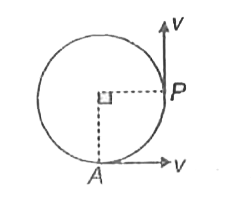A car of mass 1000 kg moves on a circular path with constant speed of 16 m/s. It is turned by 90º after travelling 628 m on the road. The centripetal force acting on the car is-
160 N
320 N
640 N
1280 N
The correct Answer is:C
To solve the problem, we need to find the centripetal force acting on a car of mass 1000 kg that is moving in a circular path with a constant speed of 16 m/s after it has turned 90 degrees while traveling a distance of 628 m.
1. Identify the Given Data:
- Mass of the car (m) = 1000 kg
- Speed of the car (v) = 16 m/s
- Distance traveled on the road (l) = 628 m
- Angle turned (θ) = 90 degrees = π/2 radians
2. Determine the Radius of the Circular Path:
- The arc length (l) for a circular path can be expressed as:
l=r⋅θ
- Rearranging this formula to find the radius (r):
r=lθ
- Substitute the values:
r=628mπ2=628×2π=1256π
- Using π≈3.14:
r≈12563.14≈400m
3. Calculate the Centripetal Force:
- The formula for centripetal force (F_c) is given by:
Fc=mv2r
- Substitute the known values:
Fc=1000kg⋅(16m/s)2400m
- Calculate v2:
v2=162=256m2/s2
- Now substitute this value back into the centripetal force equation:
Fc=1000⋅256400
- Simplifying the expression:
Fc=256000400=640N
4. Conclusion:
- The centripetal force acting on the car is 640 N.
- Mass of the car (m) = 1000 kg
- Speed of the car (v) = 16 m/s
- Distance traveled on the road (l) = 628 m
- Angle turned (θ) = 90 degrees = π/2 radians
- The arc length (l) for a circular path can be expressed as:
l=r⋅θ
- Rearranging this formula to find the radius (r):
r=lθ
- Substitute the values:
r=628mπ2=628×2π=1256π
- Using π≈3.14:
r≈12563.14≈400m
- The formula for centripetal force (F_c) is given by:
Fc=mv2r
- Substitute the known values:
Fc=1000kg⋅(16m/s)2400m
- Calculate v2:
v2=162=256m2/s2
- Now substitute this value back into the centripetal force equation:
Fc=1000⋅256400
- Simplifying the expression:
Fc=256000400=640N
- The centripetal force acting on the car is 640 N.
Similar Questions
A car of mass 1000 kg moves on a circular track of radius 100 m with a speed of 40 m/s. Calculate the magnitude of its angular momentum relative to the centre of the track.
View SolutionA car of mass 1000 kg is moving with a speed of 40ms−1 on a circular path of radius 400m. If its speed is increasing at the rate of 3ms−2 the total force acting on the car is
View SolutionA car of mass 300 kg is travelling on a circular track of radius 100 m with a constant speed of 60 m/s
Calculate the angular momentum ?
View SolutionA car of mass 300 kg is travelling on a circular track of radius 100 m with a constant speed of 60 m/s
Calculate the angular momentum ?
View SolutionA particle of mass 2 kg is moving in circular path with constant speed 20 m/s. The magnitude of change in velocity when particle travels from A to P will be

View SolutionA Particle of mass 'M' moves in a uniform circular path of radius 'r' with a constant speed 'v' then its centripetal acceleration is .
View SolutionA car of maas M is moving on a horizontal circular path of radius r. At an instant its speed is v and is increasing at a rate a.
View SolutionAn object of mass 5 kg moves at a constant speed of 6 m/s in a circular path of radius 2m. Find the magnitude of the object's acceleration and the net force responsible for its motion.
View SolutionA car turns a corner on a slippery road at a constant speed of 10 m /s . If the coefficient of friction is 0.5, the minimum radius of the arc in meter in which the car turns is
View Solution(A) : If a body moving in a circular path with constant speed, then no force acts on it.
(R ) : The direction of the velocity vector of a body moving in a circular path is changing
View Solution
